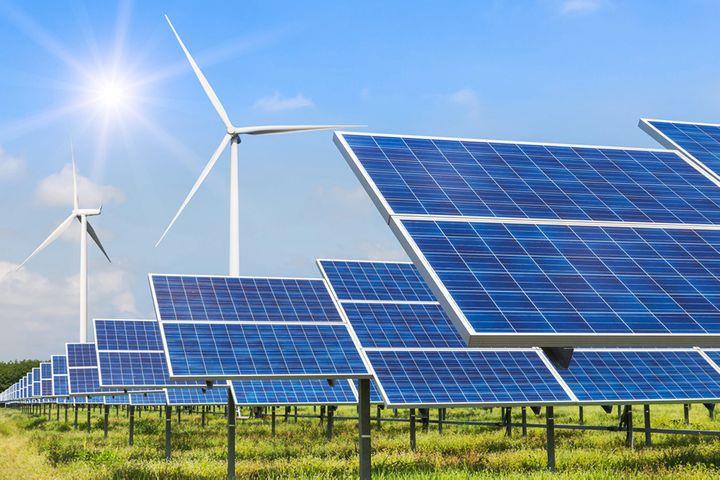 China’s Renewable Energy Impact Crosses Borders, REN21 Head Says
China’s Renewable Energy Impact Crosses Borders, REN21 Head Says(Yicai Global) June 22 -- China is a key driver in developing renewable energy globally, with the Belt and Road Initiative taking the country’s impact beyond its borders, according to the head of the Paris-based green energy think tank REN21.
China’s overseas investment in renewable energy has for the first time exceeded half of its total spending on energy projects abroad, Rana Adib told Yicai Global in a recent interview. “This is clearly a very important shift,” she said.
Adib spoke highly of what China has done in renewable energy. China leads the world, accounting for about 45 percent, or 117 gigawatts, of installed green energy capacity, after almost doubling last year, according to REN21’s Renewables 2021 Global Status Report published on June 15. It ranked first for such capacity at the end of 2020, followed by the United States, Brazil, India and Germany.
China was one of the countries that set a net zero carbon emissions target last year. At the United Nations in September, the country pledged to strive to bring its total greenhouse gas emissions to a peak by 2030 and become carbon neutral by 2060.
That commitment “is sending a strong message,” said Adib, who added that long-term targets are also not enough. “You clearly need short, medium and long-term goals and the strategy to implement it and roadmaps to do this.”
China’s first carbon trading system is expected to start this month after 10 years’ of preparation. “The advantage of a carbon trading system is that there is a price on carbon,” said Adib. But how to interconnect that regionally and globally is also very important, she said.
Countries such as China had substantial growth in renewable energy capacity additions last year, but more fossil fuels are being consumed worldwide than ever before, as the share of fossil fuels in total energy consumption has only moved from 80.3 percent to 80.2 percent in the last decade, Adib said.
“2020 could have been a game-changer because of the new level of ambition toward net zero,” she said, as energy demand fell 4 percent, but with more money pouring into the fossil fuel industry, there is a large gap between ambition and reality.
Below are excerpts from the interview.
Yicai Global: What do you think is China’s role in the field of renewable energy?
Rana Adib: China has been a driver in developing renewable energy, and is a key driver globally. China is a leader in terms of solar photovoltaics, wind and concentrated solar power and solar panel. China has been increasing very much on solar photovoltaics and wind installations in 2020 over 2019. New installations have doubled over the previous year in terms of renewable energy capacities, and that is something which is really important.
What is also interesting it that China is obviously having an impact beyond the Chinese borders under the Belt and Road Initiative. For the first time overseas investment in solar photovoltaics, wind and hydropower represented more than half of country’s total overseas energy investment.
This is clearly a very important shift, which can accelerate the transition to renewables. Unfortunately, and this is something to underline in particular in the Asian contest, coal is still very present, and China continued to lead in the global investment in coal beyond the borders.
YG: What do you think of China’s a carbon-neutral target by 2060?
RA: It is very encouraging that China now has a carbon-neutral target, and that’s important also because it is sending a strong message. What we see however is that long-term targets are not enough. You clearly need short, medium and long-term goals and the strategy to implement it and the roadmaps to do this. This is why REN21 is calling for making renewable energy, and in particular the renewable energy shares, a key performance indicator.
It’s like going to the Olympics. You don’t decide one day that you want to go to the Olympics as a sportsperson. If you want to go there, you start training yourself. You start measuring your performance. You really put this at the heart of any of your decisions and actions.
What is important is very clearly that the net-zero target from China is also translated into a renewable energy target, because there is no economic-wide renewable energy target, to sectoral targets, but also clear plans how to move in that direction and make sure that we are meeting the targets. We cannot afford not to meet the targets.
YG: China’s carbon trading system is expected to start this month. What do you think of this kind of system?
RA: The advantage is that there is a price on carbon. Everything is going to turn very much on the price that is put in this carbon trading system, and how to interconnect this in the region and also globally. So in principle, it’s one of the entry points. We need to put a price on pollution.
YG: Did the outbreak of Covid-19 slow the process of using renewable energy?
RA: 2020 could have been a game-changer because of the new level of ambition toward net zero. Also because there was an awareness happening in terms of air pollution, blue skies, the impact on biodiversity and pollution and the link to health. Also energy demand had gone down by 4 percent, so it would have been a major opportunity.
The economic recovery packages were also an opportunity from the government side to orient investment into making the shift to another future energy system. In the economic recovery packages of more than 30 countries, fossil fuel has been supported six times more than renewable energy. So we clearly see that there is a major gap between ambition and reality.
Editor: Tom Litting